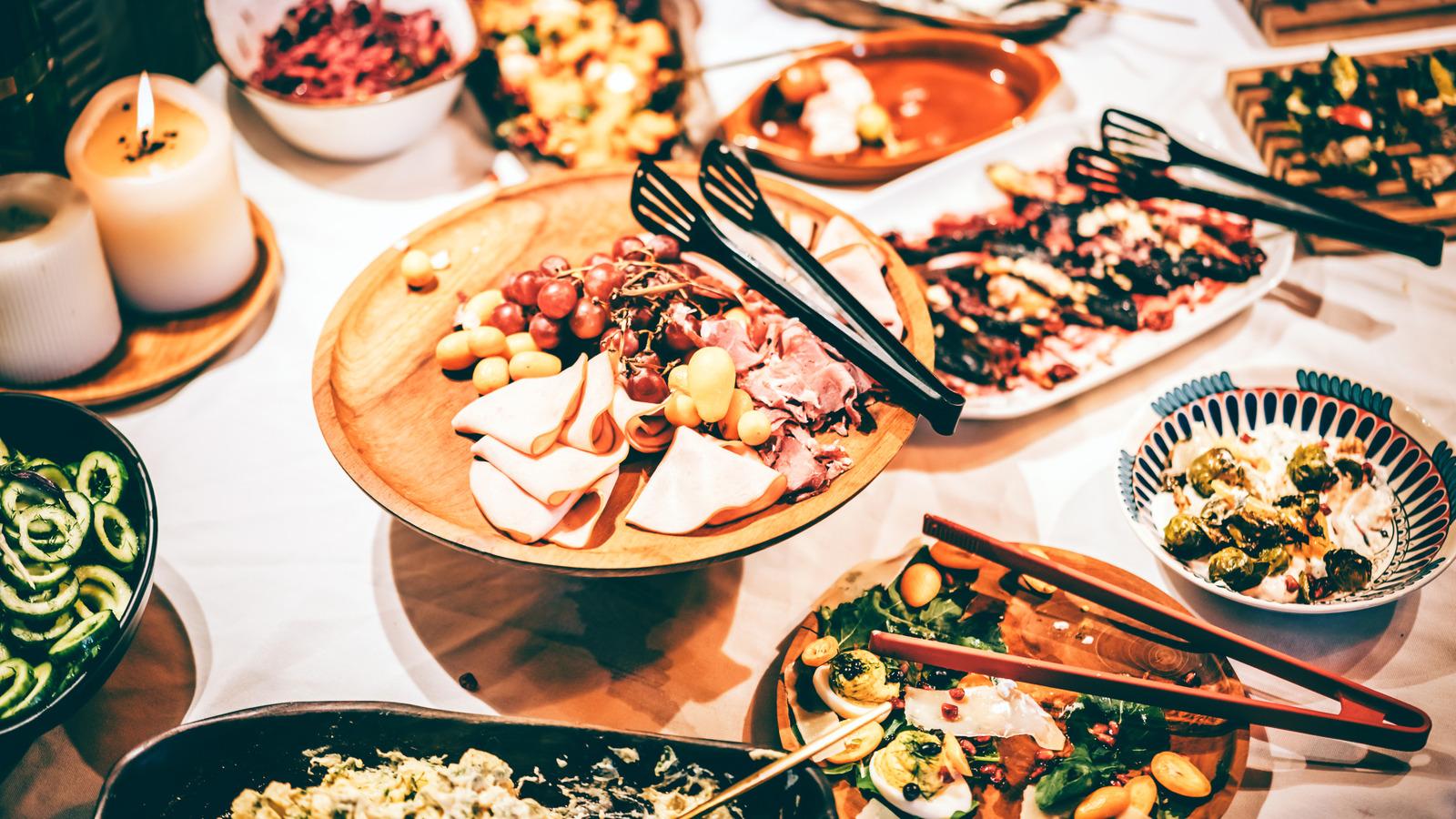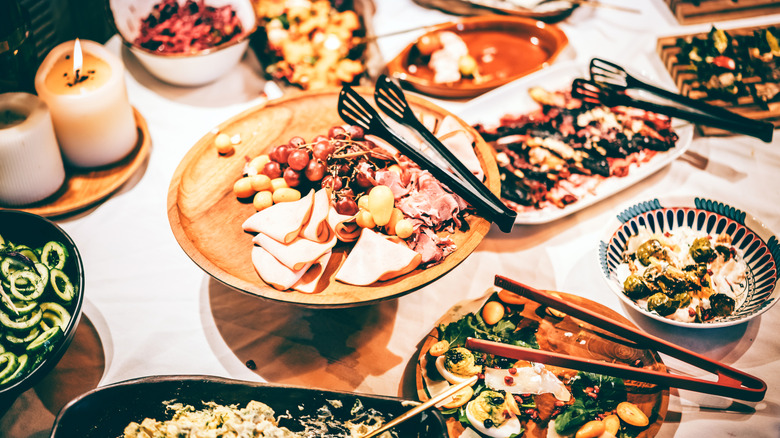
Yana Iskayeva/Getty Images
When you're craving a snack, you might open your pantry or refrigerator and go for a favorite like potato chips and dip, apples and peanut butter, Chex Mix, or maybe even a little something sweet like Oreos (or any other popular American snack). While these snacks are a common choice today among all ages and can be found in many pantries, there is a whole world of snacks that were once equally ubiquitous, but have since fallen out of the spotlight. Just like in the fashion world, foods trends come and go; different items rise to the top and — eventually — lose their appeal. While it may seem like this only applies to food groups like entrees and desserts, it also applies to snack foods. But just because something isn't popular, doesn't mean it isn't still delicious.
Here are some of the top old-school snacks and appetizers from the 20th century that have faded in popularity over the decades — but are delicious enough that we're hoping they make a resurgence.
Cheese balls
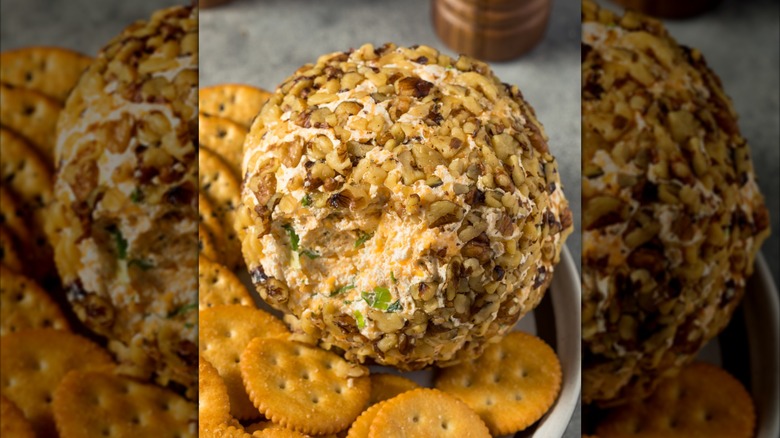
Bhofack2/Getty Images
Though cheese balls were a mainstay on the dinner party scene in the 1960s and 1970s, this delicious snack has fallen out of popularity in recent decades. Often referred to these days as "retro," this concoction first appeared in a cookbook in the mid-1940s and soon became a must-serve for hostesses across the country. Certain recipes, like Julia Child's Roquefort cheese ball, were exceedingly popular.
Classic cheese balls were typically made by mixing cream cheese with shredded cheese, spices, and other ingredients like condiments, herbs, or aromatics, and then shaping the mixture into a ball. It was then often covered in chopped nuts and served with crackers for the perfect tasty bite.
Though you probably won't find a cheese ball on offer at your next dinner party or on the menu at your favorite restaurants, there are modern variations that elevate this classic dish. To bring it into the 21st century, opt for more sophisticated cheeses (like goat's cheese) and complement the flavors with savory additions like scallions, shallots, and roasted nuts like pecans.
Cheese dreams
Cheese dreams are the perfect savory, buttery bite. This classic snack was synonymous with Southern suburban dinner parties throughout the 1950s, though similar recipes can be found in cookbooks as early as 1916. The recipe remained popular throughout the 1960s and 1970s, appearing in several Southern staple cookbooks during those decades before becoming an old-school appetizer that many people have never heard of.
This cousin of the grilled cheese sandwich is made using classic white bread and an indulgent mixture of heavy cream, cheddar cheese, butter, and spices. Top with another piece of bread — and another layer of the cheese mixture for good measure — before baking until golden brown. The middle of the "sandwich" remains melty and gooey, while the top gets a nice crunch.
Though these buttery bites were often served as appetizers at parties, they can also be eaten in ways similar to grilled cheese sandwiches; they're just as delicious paired with tomato soup or dipped in savory marinara sauce as they are on their own. Try the recipe on your next grilled cheese night for a nice change of pace.
Grape jelly meatballs
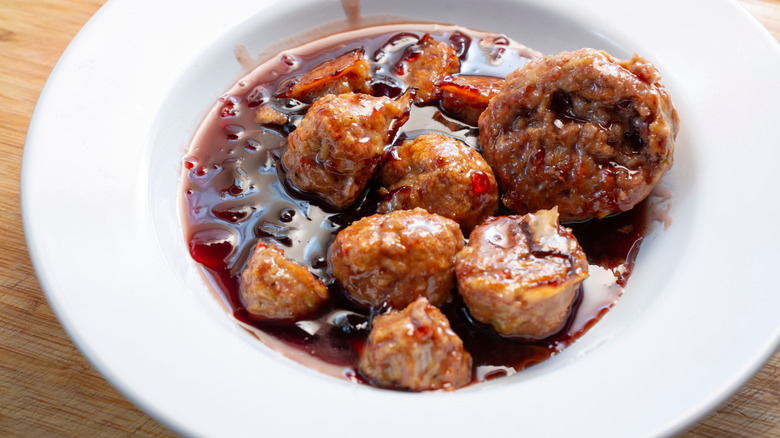
The Image Party/Shutterstock
First printed in "Elegant but Easy: A Cookbook for Hostesses" in 1960, grape jelly meatballs were beloved not only for their sweet-and-savory flavor but also for the ease of preparation — you can quickly make this recipe in a chafing dish or crockpot with minimal effort (and a lot of flavor). Word of this delicious dish spread, and grape jelly meatballs became a must-have app at cocktail parties and holiday celebrations throughout the 1960s and 1970s.
The recipe had a brief resurgence in the early 2000s, but it has once again seemed to have fallen out of the limelight in more recent years. Though a nostalgic favorite for many thanks to their longstanding popularity, you likely won't find grape jelly meatballs at your next party. But if you're looking to satisfy a craving, it's a dish that's impossibly easy to make; just mix frozen meatballs, a jar of grape jelly, and either ketchup or chili sauce (depending on your preference), and cook in the slow cooker until warmed through.
Porcupine meatballs
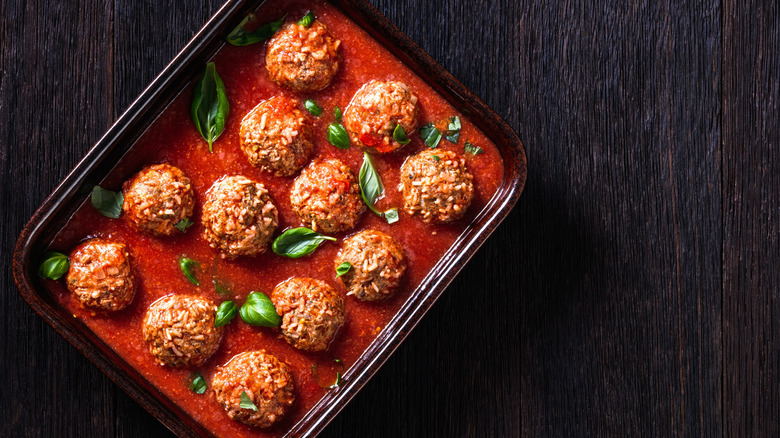
from my point of view/Shutterstock
While meatballs are traditionally made from a mix of ground meat like beef or pork, porcupine meatballs are a unique take on this classic snack. These meatballs get their unusual name from the rice mixed into the ground beef, which creates a spiky appearance. First popularized during the Great Depression, porcupine meatballs are a more affordable alternative to the all-meat variety. Thanks to their great flavor and ideal price point, this staple remained popular through World War II and well into the 1950s.
To make porcupine meatballs, the ground beef and rice meatballs are assembled and then simmered in a savory tomato sauce (similar to how you'd prepare them for spaghetti and meatballs) as they cook. This creates a rich, flavorful sauce that absorbs into the rice and meat, adding more depth of flavor. To save time, some recipes even call for simmering them in pre-made tomato soup.
Although porcupine meatballs aren't often found on dining tables these days, this simple, delicious, and affordable vintage recipe is a great option for dinner or as a snack — and is still beloved by many thanks to nostalgic memories of eating them during childhood.
Benedictine spread
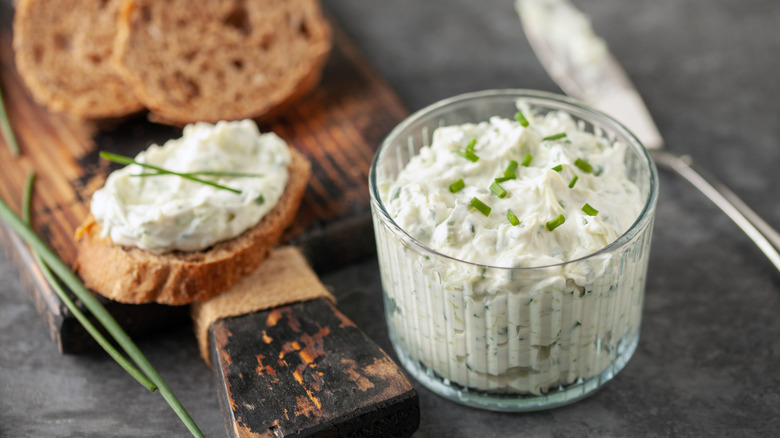
NatalyaBond/Shutterstock
If you live outside of Louisville, Kentucky, it's possible that you've never even heard of Benedictine spread. Invented by Louisville-based caterer Jennie C. Benedict at the end of the 19th century, this cucumber-and-cream-cheese concoction over time has become synonymous with the Kentucky Derby.
Though the spread is most often served on finger sandwiches made with white bread (similar to tea sandwiches), it is also served as a dip alongside chips and crackers. You'll sometimes even find it added to sandwiches (like a BLT or turkey club) in lieu of other spreads like mayo or aioli. While Benedictine spread may still be prevalent in Kentucky, you're not likely to readily find it many other places — except perhaps around the time of the Run for the Roses.
Luckily, it's easy to recreate this spread if you have a hankering or want to try it for yourself. Simply mix cream cheese, mayo, sour cream, and cucumbers with herbs, spices, and some green food coloring to give the dip its signature flavor (and color).
Rumaki
On paper, this one-bite snack may not sound appealing. But the mix of chicken liver, water chestnuts, and bacon was popular in the 1940s and 1950s, popping up on menus at tropical restaurants like the Trader Vic's restaurant chain and Don the Beachcomber in Los Angeles and Palm Springs. The tiki-inspired appetizer is a blend of cuisines, with some claiming Chinese and Hawaiian origins, and others suspecting it's a take on the classic English pub snack, angels on horseback.
Whatever the case, rumaki were beloved throughout the middle of the 20th century for their savory and sweet taste and crunchy bite, quickly becoming a must on appetizer menus and hors d'oeuvre spreads at dinner parties and other gatherings. To recreate it at home, coat chicken livers and water chestnuts in an umami-filled mixture of soy sauce, ketchup, garlic, and spices before wrapping them in bacon and sprinkling with brown sugar. The result is a sweet, savory, satisfying blend of flavors that will instantly transport you back in time.
Shrimp butter
Butter is a delicious condiment all on its own — but when you add shrimp to this salty, creamy kitchen staple, you get a totally new culinary concoction that will turn heads. The recipe first made an appearance in James Beard's "Hors D'Oeuvre and Canapés" cookbook in 1940, offering a spread that could be eaten on crackers, spread on sandwiches, or used in pasta dishes.
The one-bowl recipe has changed a bit over the years, with the renowned chef making adjustments as new versions of his cookbook were released. While the 1940 version only had shrimp, lemon juice, and spices, for example, he added onion and parsley to a later variation released in 1972 to give the butter a little more bite. Though you're not likely to find chunks of shrimp in the butter at your next dinner party or most restaurants' bread service, it's an option that's easy to whip up for those who are particularly fond of shellfish.
Olive cheese balls
These tasty, bite-sized snacks were the perfect, innovative way for olive lovers to enjoy umami morsels in a new, creative way. Made with only four ingredients, they are fast, easy, and delicious. You can even assemble them in advance, freeze them, and bake them straight from frozen when in need of an appetizer or afternoon treat.
Although the exact origin of this recipe is unclear, it seems to date back to the 1950s. And it wouldn't be a surprise; the recipe has similar ingredients to other popular mid-century dinner party favorites. The olives also make them the perfect cocktail party companion for a classic dirty martini — another mid-century staple. While they may have been first popularized over 75 years ago, these olive bites have faded from fashion. But the simple snack would likely still be devoured by olive lovers everywhere if it were to make a comeback.
Cherry winks
This classic recipe first became popular after winning the Junior Pillsbury Bake-off contest in 1950, and could be found in many cookbooks throughout the decades that followed. It's a sweet treat that, at first glance, seems like it could stand the test of time — so it's surprising that it has waned in popularity in recent decades.
The cookie dough is filled with dried fruit and nuts (similar to a fruit cake), and is formed into a chewy, delicious cookie coated in cornflakes and topped with a bright red maraschino cherry. Like most cookies, you mix the dry ingredients before creaming the sugar, butter, and other wet ingredients together. Then, simply add the dry ingredients, portion the dough, roll in cornflakes, and top with a single cherry.
The result is a snack that is the perfect blend of rich, buttery, and sweet that keeps you coming back for more. Though this particular cookie might not grace the table of your local cookie swap or be found in the pastry case of your local bakery, it's worth revisiting — especially if you've got a sweet tooth.
Vienna sausages
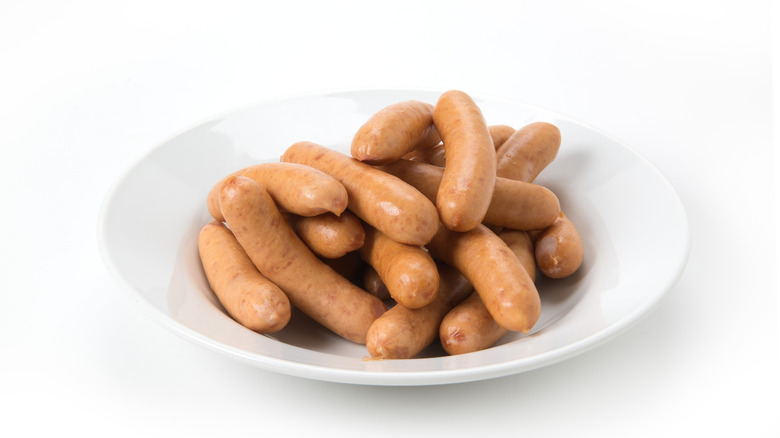
Caito/Shutterstock
As their name implies, Vienna sausages first came to the U.S. thanks to European immigrants — specifically those from the German-speaking region around Germany and Austria. Sausages were first canned in the U.S. in the 1860s, and Vienna sausages reached their peak popularity around the mid-1900s. Over time, the sausages changed to become the tiny, canned variety people know and love (though they bear little resemblance to the original sausage introduced by European immigrants).
The smoked, canned Vienna sausages are made with a combination of beef, pork, and chicken, and they were heavily advertised throughout the 1950s and well into the 1990s. Though they look like canned hot dogs, the miniature sausages have their own distinct flavor that sets them apart. Often used in sought-after appetizers like pigs in a blanket or bite-sized corn dogs, they were a household staple for many. They seem to have declined in popularity over the years — perhaps due to their high sodium content and ultra-processed flavor and texture that make them one of the canned meats many avoid.
Stuffed celery
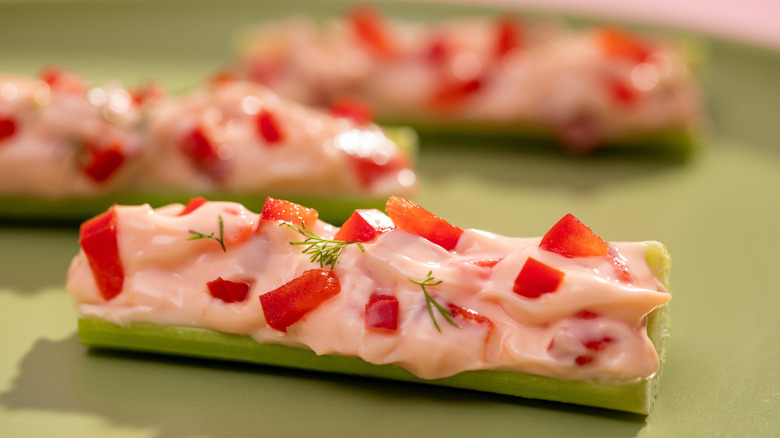
anaganeva/Shutterstock
While ants on a log was a childhood favorite for many, it's one snack that doesn't seem to have lost its appeal over the decades — unlike other variations of stuffed celery that have fallen from the limelight. During the 1950s, celery stuffed with cream cheese or pimento cheese was not an uncommon appetizer. The crunchy, flavorful snack was not only delicious, but perfect for eating one-handed at cocktail parties.
Different families seem to have had their own variation, with some featuring crushed walnuts while others had a mix of garlic and pimento-stuffed olives. But the best part about this seemingly forgotten appetizer is that you can create any mixture of flavors and textures you want; there are no right or wrong combinations.
Next time you're searching for a savory snack, skip the classic peanut butter and opt instead for a cream cheese base with your favorite fixings as an homage to this fast, easy, delicious, and nutritious snack.



